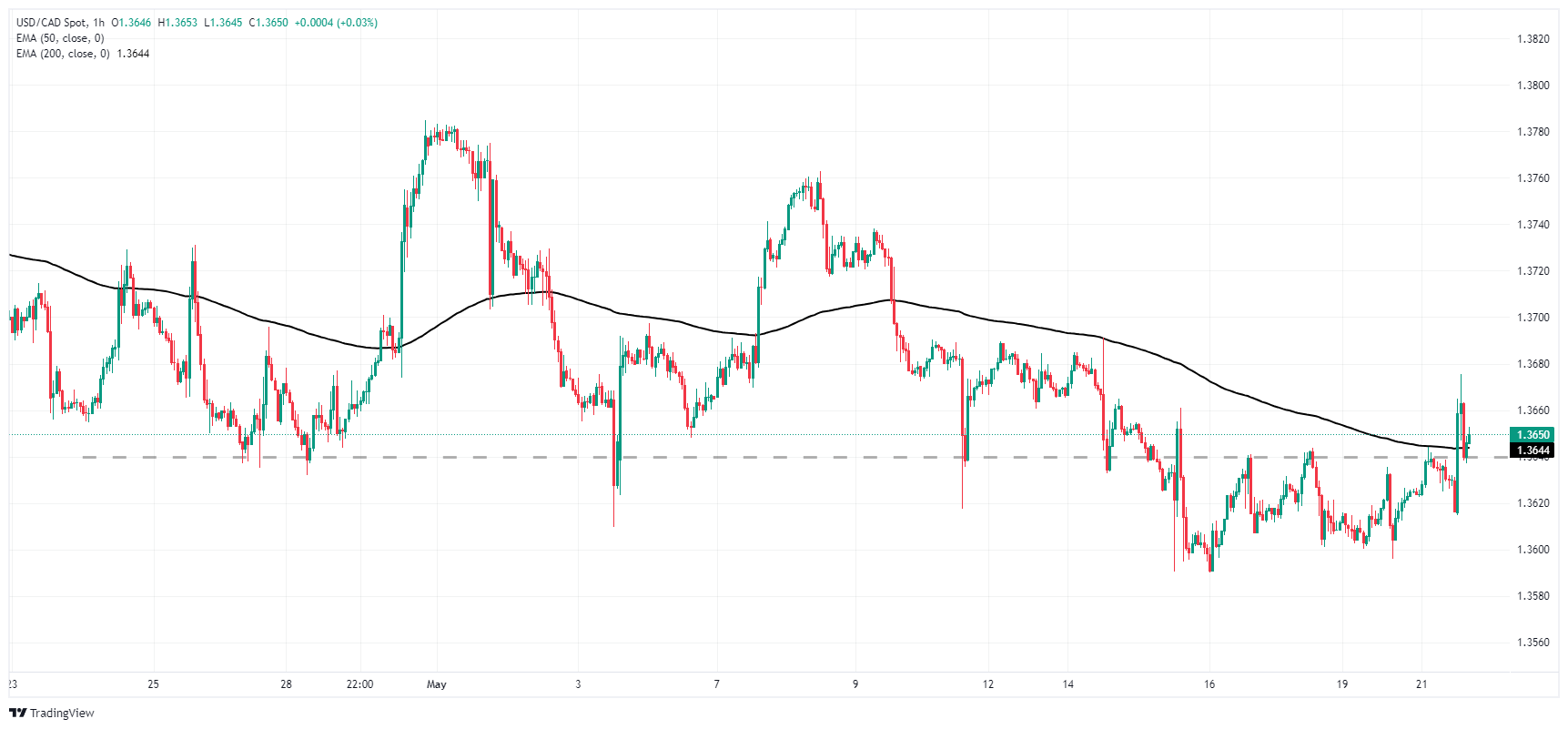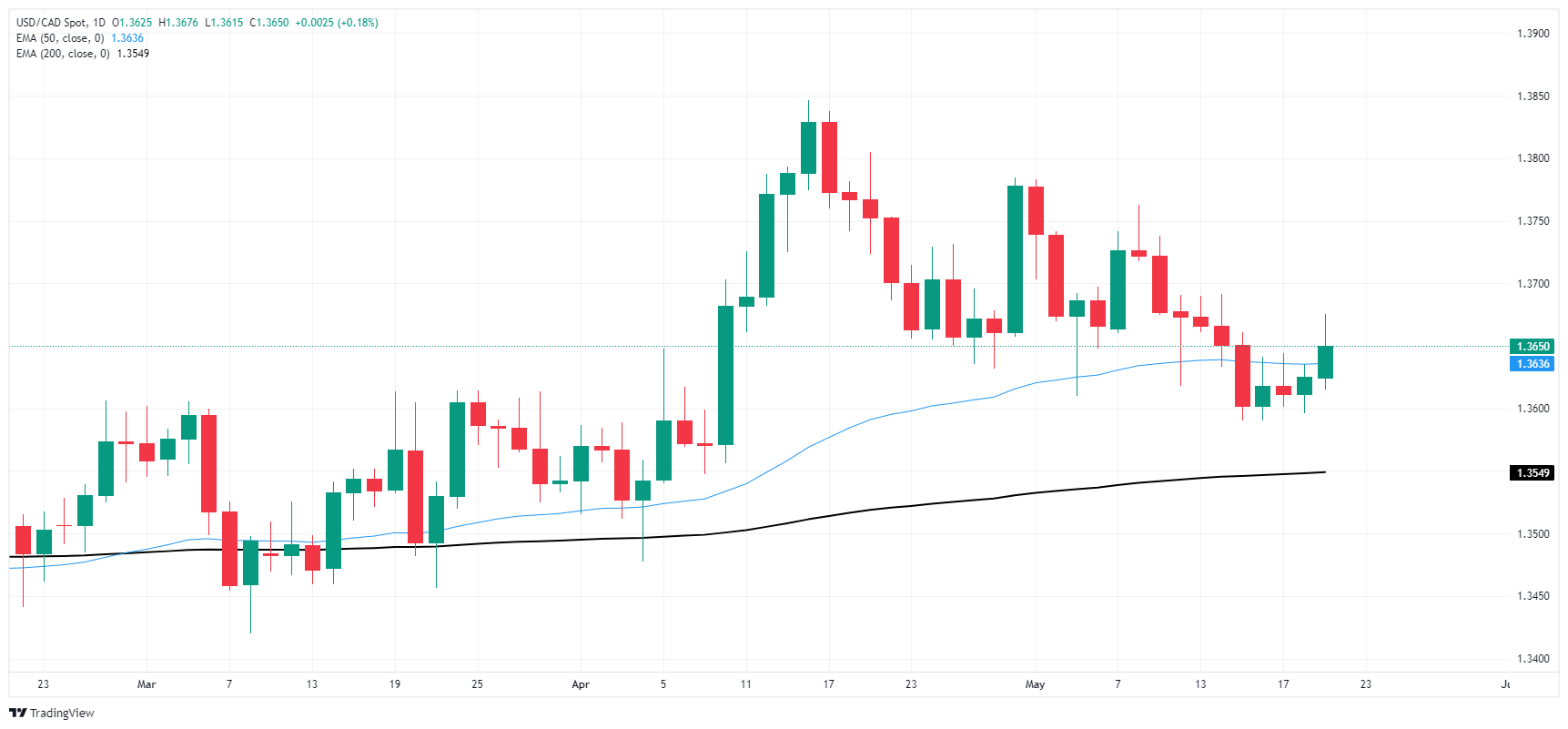- The Canadian dollar is trading lower due to the moderation of inflation in April.
- Canada sees easing price pressures and chances of a BoC rate cut in June are increasing.
- Canadian retail sales will be released at the end of the week.
The Canadian Dollar (CAD) depreciated broadly this Tuesday, with a broad decline and deflation of around a fifth of a percentage point against the US Dollar (USD), after Canadian inflation as measured by the Consumer Price Index (CPI) will moderate further in April. Markets increase their bets on a rate cut by the Bank of Canada (BoC) in June.
Canadian CPI inflation eased in line with expectations, but BoC core CPI fell to its lowest since April 2021. With price pressure easing, market bets on a rate cut in June by the BoC have increased to 48%, from 40% prior to the publication of the Canadian CPI.
Daily Market Moves Summary: Canadian Dollar Gives in as Inflation Moderates
- Canadian headline CPI inflation in April fell to 0.5% monthly, matching forecasts and reducing from 0.6% previously.
- Annual Canadian CPI inflation also met market forecasts, standing at 2.7% compared to 2.9% previously.
- The BoC's core CPI for the year ended April fell to 1.6%, down from 2.0% previously and hitting its lowest level in three years.
- Elsewhere, the Fed's speech continues to dominate overall sentiment, as officials at the US Federal Reserve (Fed) make a series of appearances in an effort to inject verbal confidence into the markets.
- Canadian retail sales will be released at the end of the week. Market forecasts expect a slight rebound to a flat 0.0% from -0.1% previously.
Canadian Dollar PRICES Today
The following table shows the percentage change of the Canadian Dollar (CAD) against the currencies listed today. The Canadian Dollar was the strongest currency against the New Zealand Dollar.
| USD | EUR | GBP | JPY | CAD | AUD | NZD | CHF | |
|---|---|---|---|---|---|---|---|---|
| USD | 0.00% | -0.04% | -0.08% | 0.16% | 0.01% | 0.16% | 0.00% | |
| EUR | -0.01% | -0.04% | -0.08% | 0.14% | 0.04% | 0.13% | 0.01% | |
| GBP | 0.04% | 0.04% | -0.06% | 0.20% | 0.05% | 0.19% | 0.04% | |
| JPY | 0.08% | 0.08% | 0.06% | 0.25% | 0.08% | 0.22% | 0.08% | |
| CAD | -0.16% | -0.14% | -0.20% | -0.25% | -0.15% | -0.01% | -0.16% | |
| AUD | -0.01% | -0.04% | -0.05% | -0.08% | 0.15% | 0.14% | 0.00% | |
| NZD | -0.16% | -0.13% | -0.19% | -0.22% | 0.01% | -0.14% | -0.15% | |
| CHF | -0.00% | -0.01% | -0.04% | -0.08% | 0.16% | 0.00% | 0.15% |
The heat map shows the percentage changes of the major currencies against each other. The base currency is chosen in the left column, while the quote currency is chosen in the top row. For example, if you choose the Canadian Dollar in the left column and move along the horizontal line to the US Dollar, the percentage change shown in the box will represent CAD (base)/USD (quote).
Technical analysis: The Canadian dollar retreats but remains in known technical territory
The Canadian Dollar (CAD) is moving in one direction on Tuesday, falling against almost all major currencies. Against the Japanese Yen (JPY), the CAD fell by a third of a percentage point, while against the US Dollar it lost a fifth of a percentage point.
The USD/CAD pair hit one-week highs, threatening to solidify a bullish rejection of the 50-day EMA from 1.3636. The pair remains below last month's highs near 1.3850, but the long-term technical floor lies at the 200-day EMA from 1.3549.
USD/CAD hourly chart
USD/CAD daily chart
The Canadian Dollar FAQs
The key factors that determine the price of the Canadian Dollar (CAD) are the level of interest rates set by the Bank of Canada (BoC), the price of oil, Canada's main export product, the health of its economy, inflation and the trade balance, which is the difference between the value of Canadian exports and its imports. Other factors are market confidence, that is, whether investors bet on riskier assets (risk-on) or look for safe assets (risk-off), with the risk-on being positive for the CAD. As its largest trading partner, the health of the US economy is also a key factor influencing the Canadian dollar.
The Bank of Canada (BoC) exerts significant influence over the Canadian Dollar by setting the level of interest rates that banks can lend to each other. This influences the level of interest rates for everyone. The BoC's main objective is to keep inflation between 1% and 3% by adjusting interest rates up or down. Relatively high interest rates are usually positive for the CAD. The Bank of Canada can also use quantitative easing and tightening to influence credit conditions, with the former being negative for the CAD and the latter being positive for the CAD.
The price of oil is a key factor influencing the value of the Canadian Dollar. Oil is Canada's largest export, so the price of oil tends to have an immediate impact on the value of the CAD. Generally, if the price of oil rises, the CAD also rises, as aggregate demand for the currency increases. The opposite occurs if the price of oil falls. Higher oil prices also tend to lead to a higher probability of a positive trade balance, which also supports the CAD.
Although inflation has traditionally always been considered a negative factor for a currency, as it reduces the value of money, the opposite has actually happened in modern times, with the relaxation of cross-border capital controls. Higher inflation often leads central banks to raise interest rates, attracting more capital inflows from global investors looking for a lucrative place to store their money. This increases the demand for the local currency, which in the case of Canada is the Canadian Dollar.
The published macroeconomic data measures the health of the economy and may have an impact on the Canadian dollar. Indicators such as GDP, manufacturing and services PMIs, employment and consumer confidence surveys can influence the direction of the CAD. A strong economy is good for the Canadian dollar. Not only does it attract more foreign investment, but it may encourage the Bank of Canada to raise interest rates, resulting in a stronger currency. However, if economic data is weak, the CAD is likely to fall.
Source: Fx Street
I am Joshua Winder, a senior-level journalist and editor at World Stock Market. I specialize in covering news related to the stock market and economic trends. With more than 8 years of experience in this field, I have become an expert in financial reporting.







